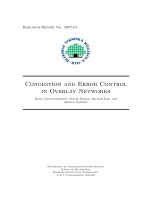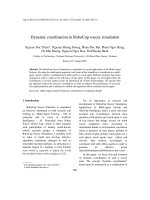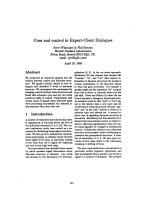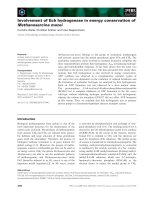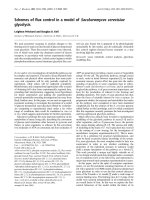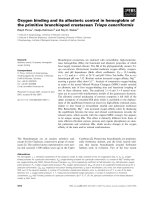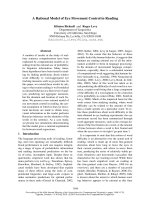Dynamic control in energy storage augmented renewable energy system
Bạn đang xem bản rút gọn của tài liệu. Xem và tải ngay bản đầy đủ của tài liệu tại đây (2.7 MB, 205 trang )
DYNAMIC CONTROL IN
ENERGY STORAGE AUGMENTED
RENEWABLE ENERGY SYSTEM
ZHOU HAIHUA
NATIONAL UNIVERSITY OF SINGA PORE
2011
DYNAMIC CONTROL IN
ENERGY STORAGE AUGMENTED
RENEWABLE ENERGY SYSTEM
ZHOU HAIHUA
(M.Eng., KTH, SWEDEN )
A THESIS SUBMITTED FOR THE DEGREE OF
DOCTOR OF PHILOSOPHY
DEPART MENT OF ELECTRICAL & COMPUTER
ENGINEERING
NATIONAL UNIVERSITY OF SINGAPORE
2011
i
Acknowledge
Firstly, I would like to express my deepest gratitude to my supervisor Prof.
Ashwin M Khambadkone for his invaluable inspiration, continuous guidance, con-
structive criticism and support throughout this research. His strict, rigorous and
professional at t it ude towards research and work also influence me a lot.
I owe so much appreciation to our lab officers: Mr. Woo Ying Chee, Mr.
Mukaya Chandra from electrical machines and drives lab, Mr. Seow Hung Cheng
from power system lab, Mr. Teo Thiam Teck from power electronic lab, Mr. Abdul
Jalil Bin Din from PCB lab and Mr. Chan Leong Hin from electrical workshop.
With their readiness help and suggestions, my hardware setup smoothly.
My five and half year in NUS is valuable experiences. From here, I have gained
not only knowledge and research experiences but also met lots of friends. My sincere
thanks go to Dr. Wu Xinhui for her friendship and accompany; Dr. Kong Xin, Mr.
Singh Ravinder Pal and Mr. Tran Duong for their valuable discussions on the design
and development of my project; I would like to thank my fellow research scholars
from electrical machines lab and power electronics lab: Mr. Krishna Mainali, Mr.
Tan Yen Kheng, Dr. Sahoo Sanjib Kumar Miss. Yu Xiaoxiao, Miss. Li Yanlin,
ii
Miss Lim Shufan, Miss Wang Huanhuan, Mr. Souvik Dasgupta, Mr. Hoang Duc
Chinh, Mr. Yadalv Parikshit , Mr. Sangit Sasidhar and Mr. Ko Ko Win.
My warmest thanks go to my friends in Modern Project: Mr. Terence Siew,
Dr. Tanmoy Bhattacharya, Mr. Goh Qingzhuang, Ms Htay Nwe Aung, Dr. Sundar
Raj Thangavelu and Mr. Thillainathan Logenthiran. In Modern project, we unite
together and progress further. I am proud to have colleagues like you all.
I will treasure the friendship with Mr. Huang Zhihong, Mr. Ng Sweepeng,
Ms. Qia n Weizhe, Ms. Ku Cik Ling, Mr. Lee Weixian and Ms. Ren Weiwei.
Thanks all my friends who take care of me and support me. I appreciate all the
precious mo ments we have shared together.
Lastly but not least, I would like to thank my parents and parents-in-law for
their endless love, encouragements and infinite support. My heart felt gratitude to
my husband, Dr. Mo Weirong, who is always there to give me care, understanding
and support.
i
Contents
Acknowledgement i
Summary vi
List of Tables ix
List of Figures x
Acronyms xvi
1 Introduction 1
1.1 Problem Definitions . . . . . . . . . . . . . . . . . . . . . . . . . . . 5
1.2 Contributions of the thesis . . . . . . . . . . . . . . . . . . . . . . . 7
1.3 Organization of the thesis . . . . . . . . . . . . . . . . . . . . . . . 8
2 Hybrid modulation to widen power transfer capability 11
ii
2.1 Introduction . . . . . . . . . . . . . . . . . . . . . . . . . . . . . . . 11
2.2 Literature review of bi-directional converter . . . . . . . . . . . . . 14
2.3 Conventional modulatio n in DAB . . . . . . . . . . . . . . . . . . . 20
2.3.1 Operating principle of DAB . . . . . . . . . . . . . . . . . . 20
2.3.2 Average output current in DAB . . . . . . . . . . . . . . . . 21
2.3.3 Parameters selection for DAB design . . . . . . . . . . . . . 25
2.4 Limitations of conventional modulations . . . . . . . . . . . . . . . 30
2.4.1 Trapezoidal modulat ion (TZM) . . . . . . . . . . . . . . . . 34
2.4.2 Triangular modulation (TRM) . . . . . . . . . . . . . . . . . 35
2.5 Hybrid modulation widen power transfer . . . . . . . . . . . . . . . 39
2.6 Exp erimental results . . . . . . . . . . . . . . . . . . . . . . . . . . 43
2.7 Conclusions . . . . . . . . . . . . . . . . . . . . . . . . . . . . . . . 47
3 Feedback linearization for DAB 48
3.1 Introduction . . . . . . . . . . . . . . . . . . . . . . . . . . . . . . . 48
3.2 Nonlinearity in hybrid modula tion . . . . . . . . . . . . . . . . . . . 50
3.3 Feedback linearization controller design . . . . . . . . . . . . . . . . 52
3.3.1 Feedback linearization controller . . . . . . . . . . . . . . . . 52
3.3.2 Mode selection . . . . . . . . . . . . . . . . . . . . . . . . . 56
iii
3.4 Exp erimental results . . . . . . . . . . . . . . . . . . . . . . . . . . 57
3.5 Summary . . . . . . . . . . . . . . . . . . . . . . . . . . . . . . . . 59
4 Passivity based control for I C FFB converter 60
4.1 Introduction . . . . . . . . . . . . . . . . . . . . . . . . . . . . . . . 60
4.2 Non-minimum phase characteristics in boo st converter . . . . . . . 63
4.3 Background of Passivity Based Control . . . . . . . . . . . . . . . . 66
4.4 Dynamic model o f CFFB using Mixed Potential Function (MPF) . 69
4.4.1 Formulating Mixed Potential Function (MPF) for boost con-
verter . . . . . . . . . . . . . . . . . . . . . . . . . . . . . . 70
4.4.2 Dynamic model of CFFB using Mixed Potential Function
(MPF) . . . . . . . . . . . . . . . . . . . . . . . . . . . . . . 72
4.5 Passivity Based Controller (PBC) Design . . . . . . . . . . . . . . . 76
4.5.1 Determining control variable for PBC with series injection . 81
4.5.2 Stability of PBC controller . . . . . . . . . . . . . . . . . . . 8 2
4.5.3 Tuning the PBC controller . . . . . . . . . . . . . . . . . . . 83
4.5.4 Augmented integral action for zero steady state erro r . . . . 85
4.6 Exp erimental results and discussion . . . . . . . . . . . . . . . . . . 88
4.7 Controller performance discussion . . . . . . . . . . . . . . . . . . . 9 5
4.7.1 Direct voltage control . . . . . . . . . . . . . . . . . . . . . . 95
iv
4.7.2 Cascaded current control . . . . . . . . . . . . . . . . . . . . 96
4.7.3 Performance comparison and discussion . . . . . . . . . . . . 97
4.8 Discussion a nd conclusion . . . . . . . . . . . . . . . . . . . . . . . 99
5 Dynamic power distribution in storage augmented renewable en-
ergy system 101
5.1 Introduction . . . . . . . . . . . . . . . . . . . . . . . . . . . . . . . 101
5.2 Small Sig na ls Modeling of ICFFB and DAB converters . . . . . . . 103
5.3 Controller Design . . . . . . . . . . . . . . . . . . . . . . . . . . . . 1 06
5.4 Accurate Model of ICFFB converter . . . . . . . . . . . . . . . . . . 114
5.4.1 Model identification . . . . . . . . . . . . . . . . . . . . . . . 116
5.4.2 Data acquisition . . . . . . . . . . . . . . . . . . . . . . . . . 117
5.4.3 Model selection . . . . . . . . . . . . . . . . . . . . . . . . . 119
5.4.4 Model fitting . . . . . . . . . . . . . . . . . . . . . . . . . . 120
5.4.5 Model evaluation . . . . . . . . . . . . . . . . . . . . . . . . 125
5.5 Exp erimental results . . . . . . . . . . . . . . . . . . . . . . . . . . 125
5.6 Summary . . . . . . . . . . . . . . . . . . . . . . . . . . . . . . . . 129
6 Interleaved DAB Converter in Micro-Grid application 130
6.1 Introduction . . . . . . . . . . . . . . . . . . . . . . . . . . . . . . . 130
v
6.2 Flexible combinations of converters . . . . . . . . . . . . . . . . . . 132
6.3 Operating principles of Interleaved IPOS DAB converter . . . . . . 135
6.4 Controller design for interleaved IPOS DAB converter . . . . . . . . 137
6.5 Simulation Results . . . . . . . . . . . . . . . . . . . . . . . . . . . 138
6.6 Summary . . . . . . . . . . . . . . . . . . . . . . . . . . . . . . . . 143
7 Conclusion and future work 146
7.1 Conclusion . . . . . . . . . . . . . . . . . . . . . . . . . . . . . . . . 146
7.2 Future work . . . . . . . . . . . . . . . . . . . . . . . . . . . . . . . 148
Bibliography 150
A Description of hardware 160
1.1 Overview of the implementation scheme . . . . . . . . . . . . . . . 160
1.2 dSPACE DS11 04 . . . . . . . . . . . . . . . . . . . . . . . . . . . . 162
1.3 Generating high frequency phase shifted PWM signals . . . . . . . 162
1.4 Specifications of power converters . . . . . . . . . . . . . . . . . . . 164
B Experiments 168
vi
Summary
Renewable energy is a way to solve the energy crisis problem. However,
its slow dynamic response or/and intermittent characteristics prohibit its wide
applications.
Energy storage system is thus needed to satisfy the differences between source
and load. To actively control power flow and to meet voltage differences between
energy storage and load, power electronic converter is essential.
The objective of this thesis a r e
• To design and control a bi- directional converter in a wide operating range for
energy storage
• To design and control an energy storage augmented renewable source system
to maximally use the renewable power and to satisfy load requirements
Energy storage a nd load requirements specify the bi-directional converter
design and control. Energy storage provides low and varying output volta ge while
load voltage can be high. Phase shifted D ual Active Bridge (DAB) converter
provides high voltage boo st ra t io and nature isolation. Therefore DAB is chosen
here. Since the terminal voltage of energy storage and the load power always
vary, it is desirable that DAB op erates in a wide operat ing range. In the thesis,
a hybrid modulation scheme is proposed and implemented to widen the power
transfer capability in DAB. Feedback liberalization controller is designed to r egula te
the voltage in a linear form.
In energy stor age augmented renewable energy system, a power electronic
converter is also needed to actively control power flow between the renewable en-
ergy source and the DC bus. Similar to energy storage, its terminal voltage can be
also low and varying while DC voltage can be high. Boost type converter is usually
preferred. Control of boost type converter naturally faces difficulties in designing a
stable wide bandwidth controller. This is due to its non-minimum phase shift rela-
tionship between output voltage and control variable. A passivity based controller
(PBC) is investigated. Results show the non- minimum phase shift relationship still
exists in the boost converter but by proper injecting the damping in the current
trajectory, PBC controller can achieve a stable voltage regulation in a wide range
as well as maintain a good dynamic performance.
The design objectives of the energy stor age augmented renewable source sys-
tem are to use renewable p ower as much as possible and to regulate the bus voltage.
Energy management scheme then is designed to coordinate power flow between
renewable source and energy storage. Current regulat ion is implemented for re-
newable source while voltage regulatio n is achieved by energy storag e. Simulation
and experimental results show t he effectiveness of source current regulation and
fast load dynamic response. An accurate model to reflect the relationship b etween
load current and source current is also built.
Further, the bi-directional DAB converter system can be extended in micro-
grid application. The size of energy storage for microg r id application range from
hundred kW to few MW. Thus power rating of the bi-directional converter is high.
In addition, energy storages can have different functions in a microgrid. For in-
stance, it can function as energy buffer to shift power between two time zones or it
can function as power source to support load peak power demands. Modular design
achieves high flexibility hence it is used. The proposed modular structure can be
scaled up to a ny power and energy. By properly connecting the modules in series
or in parallel, various combinations are possible to meet different source and load
requirements. Interleaved scheme is also implemented in modules to reduce input
and output ripple. Therefore input and output filter size are r educed. Simulation
results confirm that the proposed interleaved modular DAB converter achieves the
desired performances.
ix
List of Tables
1.1 Voltage swing in different energy storages . . . . . . . . . . . . . . . 10
2.1 Numerical parameters . . . . . . . . . . . . . . . . . . . . . . . . . 44
3.1 Inverse function of phase shift and proposed triangular modulations 54
4.1 Parameters of controller implementation . . . . . . . . . . . . . . . 94
5.1 Error comparison between the ideal and fitted model under V
g
=28V 124
5.2 Error between model and experimental results . . . . . . . . . . . . 126
6.2 Simulation parameters (1) . . . . . . . . . . . . . . . . . . . . . . . 1 39
6.3 Simulation parameters (2) . . . . . . . . . . . . . . . . . . . . . . . 1 40
6.1 Comparison of devices stress under same output power . . . . . . . 145
A.1 ICFFB converter specification (a) . . . . . . . . . . . . . . . . . . . 165
A.2 ICFFB converter specification (b) . . . . . . . . . . . . . . . . . . . 166
A.3 DAB converter specification . . . . . . . . . . . . . . . . . . . . . . 167
B.1 Physical IO address mapping between FPGA and dSPACE . . . . . 169
x
List of Figures
1.1 Typical 24 hours power profile . . . . . . . . . . . . . . . . . . . . . 2
1.2 Block diagram in using energy storage for var ious applications . . . 3
1.3 Block diagram of augmented system with DC-DC front-end converter 4
1.4 Block diagram of augmented system with DC-AC front-end converter 5
2.1 Ragone chart for alternative sources . . . . . . . . . . . . . . . . . . 12
2.2 Buck boost Converter . . . . . . . . . . . . . . . . . . . . . . . . . . 15
2.3 Key waveforms in buck boo st converter . . . . . . . . . . . . . . . . 15
2.4 Half Bridge Dual Active Converter . . . . . . . . . . . . . . . . . . 1 7
2.5 Waveforms of half bridge dual active converter . . . . . . . . . . . . 17
2.6 Current Fed Full Br idge Converter . . . . . . . . . . . . . . . . . . 18
2.7 Key waveforms in the current-fed full bridge . . . . . . . . . . . . . 18
2.8 Topology of DAB converter . . . . . . . . . . . . . . . . . . . . . . 19
2.9 Waveforms of PSM under positive power transfer . . . . . . . . . . 2 0
2.10 Waveforms of PSM under negative power transfer . . . . . . . . . . 20
2.11 Key waveforms in Dual Active Bridge Converter . . . . . . . . . . . 22
2.12 Equivalent circuit during interval [t
0
,t
4
] . . . . . . . . . . . . . . . . 23
2.13 Relationship between the power factor and phase shift . . . . . . . 26
2.14 Relationship between power and phase shift under various leakage
inductance . . . . . . . . . . . . . . . . . . . . . . . . . . . . . . . . 27
2.15 Voltage across transformer under (a)Ideal case (b) Practical case
with large φ (c) Practical case with small φ . . . . . . . . . . . . . 28
2.16 Peak current under different turns ratio . . . . . . . . . . . . . . . . 30
2.17 Block diagram of energy storage augmented renewable source system 31
2.18 Desired power range of energy storage system . . . . . . . . . . . . 31
2.19 Desirable output power P
o
vs input voltage V
1
. . . . . . . . . . . . 32
2.20 Simulation when positive power transfer operate under pha se shift
alone . . . . . . . . . . . . . . . . . . . . . . . . . . . . . . . . . . . 33
2.21 TZM under positive power transfer . . . . . . . . . . . . . . . . . . 34
2.22 TZM under negative power transfer . . . . . . . . . . . . . . . . . . 3 4
2.23 TRM under positive power transfer . . . . . . . . . . . . . . . . . . 35
2.24 TRM under negative power transfer . . . . . . . . . . . . . . . . . . 35
2.25 Limitation of the TZM modulation . . . . . . . . . . . . . . . . . . 37
2.26 Limitation of the TRM modulation . . . . . . . . . . . . . . . . . . 37
2.27 Key waveforms of proposed triangular modulation (PTRM) . . . . . 39
2.28 Waveforms of proposed triangular modulation . . . . . . . . . . . . 40
2.29 Relationship between P
o
and V
1
under PTRM . . . . . . . . . . . . 42
2.30 Hybrid modulatio n to achieve the desirable output power . . . . . . 43
2.31 Schematic of hardware implementation . . . . . . . . . . . . . . . . 43
2.32 Transformer waveforms . . . . . . . . . . . . . . . . . . . . . . . . . 45
2.33 Transformer waveforms when power changes between 300W and 900W 46
2.34 Zero voltage switching (a) S5 ZVS turn on (b) S6 ZVS turn on . . . 46
3.1 Relationship between i
DAB
and φ under PSM . . . . . . . . . . . . 51
3.2 Relationship between i
DAB
and D under PTRM . . . . . . . . . . . 51
3.3 Control diagram by using feedback linearization . . . . . . . . . . . 52
3.4 Topology of DAB converter . . . . . . . . . . . . . . . . . . . . . . 52
3.5 Comparison between the ideal and practical inverse model . . . . . 55
3.6 Hysteresis comparison block . . . . . . . . . . . . . . . . . . . . . . 57
3.7 Response when power changes between 800 W and 1200 W when
(V
1
=30V) . . . . . . . . . . . . . . . . . . . . . . . . . . . . . . . . 57
3.8 Response when power changes between 650W to 1200W . . . . . . 58
3.9 Response when power changes between 300W and 900W . . . . . . 59
4.1 Dynamic response when duty ratio step changes from 0.4 to 0.6 . . 63
4.2 Interleaved Current Fed Full Bridge Converter(ICFFB) . . . . . . . 64
4.3 Basic RLC circuit . . . . . . . . . . . . . . . . . . . . . . . . . . . . 67
4.4 Topology of boost converter . . . . . . . . . . . . . . . . . . . . . . 70
4.5 Interleaved Current Fed Full Bridge Converter(ICFFB) . . . . . . . 73
4.6 Single Current Fed Full Bridge Converter (CFFB) . . . . . . . . . . 73
4.7 Key waveforms in ICFFB . . . . . . . . . . . . . . . . . . . . . . . 75
4.8 Control block for proposed PBC with augmented integrator and load
estimator . . . . . . . . . . . . . . . . . . . . . . . . . . . . . . . . 76
4.9 Possible damping injection in CFFB . . . . . . . . . . . . . . . . . 77
4.10 Procedures to design the BM based PBC controller . . . . . . . . . 77
4.11 D vs i
L1
under var ious R
i
. . . . . . . . . . . . . . . . . . . . . . . 83
4.12 Selection of R
i
when V
g
ranges from 28V to 42V . . . . . . . . . . . 84
4.13 Control block for proposed PBC with augmented integrator and load
estimator . . . . . . . . . . . . . . . . . . . . . . . . . . . . . . . . 86
4.14 Dynamic load equivalent circuit . . . . . . . . . . . . . . . . . . . . 8 7
4.15 Voltage waveforms measured in the ICFFB system . . . . . . . . . 89
4.16 Steady state current waveforms of the ICFFB converter . . . . . . . 90
4.17 Steady state voltage waveforms of the ICFFB converter . . . . . . . 90
4.18 Step responses under series damping PBC alone . . . . . . . . . . . 92
4.19 Step responses under integrator augmented PBC with measured load 92
4.20 Step responses under integrator augmented PBC with estimated
load . . . . . . . . . . . . . . . . . . . . . . . . . . . . . . . . . . . 93
4.21 Waveforms when V
g
=18V and P
o
=270W to 540W . . . . . . . . . . 93
4.22 Waveforms when V
g
=24V and P
o
=360W to 720W . . . . . . . . . 94
4.23 Waveforms when V
g
=30V and P
o
=450W to 900W . . . . . . . . . . 94
4.24 Control diagram of direct voltage control . . . . . . . . . . . . . . . 9 5
4.25 Bode diagram (a) Direct voltage control . . . . . . . . . . . . . . . 96
4.26 Control diagram of cascaded current control . . . . . . . . . . . . . 97
4.27 Comparison of step response between 600W and 1200W . . . . . . 9 8
5.1 Topology of augmented system using ICFFB and DAB . . . . . . . 104
5.2 DC link voltage control scheme of the augmented system . . . . . . 106
5.3 Reference current generating using maximum power point tracking
technique . . . . . . . . . . . . . . . . . . . . . . . . . . . . . . . . 109
5.4 Simplified block diagram of the closed loop a ugmented system . . . 111
5.5 Nyquist plot of C
v
(s) × G(s) for varia tion in control gain (K
v
) . . . 112
5.6 Nyquist plot for C
v
(s) × G(s) using the controller C
v
(s) . . . . . . . 112
5.7 Dynamic response when when controllable source is used . . . . . . 1 14
5.8 Procedures to achieve the data fitting . . . . . . . . . . . . . . . . . 116
5.9 Setup for data acquisition . . . . . . . . . . . . . . . . . . . . . . . 117
5.10 Flow chart for the data acquisition process . . . . . . . . . . . . . . 118
5.11 Algorithm of the trust region approach . . . . . . . . . . . . . . . . 122
5.12 Comparison between ideal, fitted and exp erimental results (V
g
=27
to 30V) . . . . . . . . . . . . . . . . . . . . . . . . . . . . . . . . . 123
5.13 Comparison between ideal, fitted and experimental results (V
g
=28V) 124
5.14 Block diagram: dSPACE implementation of the controller . . . . . 125
5.15 Dynamic response comparison between ICFFB alo ne and hybrid
converter . . . . . . . . . . . . . . . . . . . . . . . . . . . . . . . . . 128
6.1 Possible configurations of module based converters . . . . . . . . . . 132
6.2 Topology of IPOS interleaved DAB . . . . . . . . . . . . . . . . . . 135
6.3 Typical waveforms in IPOS interleaved DAB . . . . . . . . . . . . . 136
6.4 Control block diagram for the IPOS interleaved DAB converter . . . 137
6.5 Waveforms of voltage and current in transformer . . . . . . . . . . . 141
6.6 Waveforms of input current . . . . . . . . . . . . . . . . . . . . . . 142
6.7 Output voltage waveform when load steps between 2.4kW and 4.8kW
143
A.1 Block diagram of hardware implementatio n . . . . . . . . . . . . . . 161
A.2 Block diagram of the controller interfacing board . . . . . . . . . . 164
B.1 I/ O definition in FPGA program . . . . . . . . . . . . . . . . . . . 170
B.2 FPGA program for phase shifted PWM signals . . . . . . . . . . . . 176
B.3 DAB secondary side power stage . . . . . . . . . . . . . . . . . . . . 177
B.4 Filter design layout . . . . . . . . . . . . . . . . . . . . . . . . . . . 178
B.5 Driver circuit layout . . . . . . . . . . . . . . . . . . . . . . . . . . 179
B.6 Interface board between FPGA and dSPACE . . . . . . . . . . . . . 180
B.7 L oad switches board . . . . . . . . . . . . . . . . . . . . . . . . . . 181
xvi
Acrony ms
ICFFB Interleaved Current Fed Full Bridge
CFFB Current Fed Full Bridge
DAB Dual Active Bridge
SOC State Of Charge
TZM Trapezoidal Modulation
TRM Triangular Modulation
PSM Phase Shift Modulation
PTRM Proposed Triangular Modulation
MPF Mixed Potential Function
BM Brayton Moser
PBC Passivity Based Control
IPOS Input Parallel Output Seires
IPOP Input Parallel Output Parallel
ISOP Input Series Output Parallel
ISOS Input Series Output Series
ZVS Zero Voltage Switching
FPGA Field Prog rammable Gate Array
PWM Pulse Width Modulation
1
Chapter 1
Introduction
In modern societies, power generation is mainly dependant on the burning of
fossil fuels. However, natural resources such as petroleum, coal, and natural gas
are limited in supply, while our energy demand keeps on increasing. According
to [1], if our energy demand increases by 2.4% per year, our total fossil fuel will be
depleted after 75 years. The situation becomes even worse if the energy demand
increases by a rate of 5%, then there is only 50 years of supply left. To continuously
meet our energy demand, we have to use energy efficiently as well as to utilize more
renewable energy such as Photovoltaics (PV) and wind etc [2].
Renewable energy, which harnesses the natural resources such as sun and
wind,is intermittent in nature, see PV power output in Fig. 1.1(b). On the other
hand, load demand can be continuous and varying, see residential load demand as
2
Fig. 1.1(a). To use renewable energy as the primary source, energy storage system
should compensate the differences between renewable source and load, its power
profile is shown as Fig. 1.1(c).
Figure 1.1: Typical 24 hours power profile
(a)Residential load (b)PV source (c) Energy storage
Other than mitigating the intermittency, energy storage system has many
applications such as power quality improvement, load shaving, peak power shaving
and frequency regulation for grid connected wind power etc [3]. Some structures to
connect energy storage with the load are shown in Fig. 1.2. In Fig. 1.2(a)(b), DC
type energy storages such as batteries are connected to grid via a Voltage Source
Converter (VSC) while super-conducting coil and flywheels, shown as Fig. 1.2(c)(d),
are connected via D C- DC and DC-AC converters to the power system [4]. There-
fore, power electronics converters ar e indispensable in energy storage system.
3
Figure 1.2: Block diagram in using energy storage for various applications
Fig. 1.3 shows the block diagram to connect DC type of renewable energy
and energy storage via power converter with different types of load [5].
From Fig. 1.3, we can see that the energy storage is connected to D C bus
via a bi-directional converter, see shaded block in the figure. This bi-directional
converter plays a very important role. It boosts/bucks source voltage to another
DC bus voltage and regulates the DC bus.
4
Renewable
Source
DC − DC
Converter
Energy
Storage
Bidirectional
Converter
DC − AC
Converter
AC
Load
DC
Load
DC − DC
Converter
DC
Load
(a)
(b)
(c)
LOAD
Figure 1.3: Block diagram of augmented system with DC-DC front-end converter
The other possible system block diag ram to connect renewable source and en-
ergy storage to different loads is shown in Fig. 1.4. In this approach, energy storage
is directly connected to AC bus via a bi-directiona l converter. If energy storage
voltage is low and a high AC bus voltage is required, a high boosting capability
transformer is needed. However, this 50 Hz transformer can be significantly bulky
and costly. At the same time, AC-AC converter using DC link as intermediate is
inefficient due to the fact that one more power conversion stage is involved. In
addition, terminal voltage of the energy storage, as Table. 1.1 shows, varies a lot.
This poses difficulties in DC-AC converter modulation if energy storage is directly
connect to DC-AC converter.
As a result, system structure shown as Fig. 1.3 is preferably used in this
thesis to connect DC type of energy storage with other DC type renewable en-
ergy. Therefore, the focus of this thesis is to explore how to design and control
a bi-directional converter for energy storage and how to control energy storage

